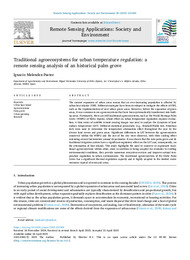Por favor, use este identificador para citar o enlazar este ítem:
https://hdl.handle.net/11000/38279Registro completo de metadatos
| Campo DC | Valor | Lengua/Idioma |
|---|---|---|
| dc.contributor.author | Meléndez-Pastor, Ignacio | - |
| dc.contributor.other | Departamentos de la UMH::Agroquímica y Medio Ambiente | es_ES |
| dc.date.accessioned | 2025-11-18T11:30:28Z | - |
| dc.date.available | 2025-11-18T11:30:28Z | - |
| dc.date.created | 2025-04 | - |
| dc.identifier.citation | Remote Sensing Applications: Society and Environment, Vol. 38 (2025) | es_ES |
| dc.identifier.issn | 2352-9385 | - |
| dc.identifier.uri | https://hdl.handle.net/11000/38279 | - |
| dc.description.abstract | The current expansion of urban areas means that an ever-increasing population is affected by urban heat islands (UHI). Different strategies have been developed to mitigate the effects of UHI, such as the implementation of new urban green areas. However, before the expansion of green areas, it was common to see agroecosystems that have been systematically transformed into builtup areas. Fortunately, there are still traditional agroecosystems, such as the World Heritage Palm Grove (WHPG) of Elche (Spain), whose effect on urban temperature regulation requires evaluation. A time series of satellite remote sensing images was used to analyse the dynamics of land surface temperature (LST). Different statistical procedures (e.g., Kruskall-Wallis test, Friedman test) were used to determine the temperature attenuation effect throughout the year by the diverse land covers and green areas. Significant differences in LST between the agroecosystem conserved within the WHPG and the rest of the city were observed, with their cooling effect extending several hectometers around its perimeter. It was shown that the date palm grove and its traditional irrigation system have a significant regulatory effect on the LST and, consequently, on the attenuation of heat islands. This study highlights the need to conserve or regenerate traditional agroecosystems within cities, since in addition to being adapted for centuries to existing environmental conditions, they provide numerous ecosystem services and improve natural temperature regulation in urban environments. The traditional agroecosystem of the Elche Palm Grove has a significant thermal regulation capacity and is highly adapted to the limited water resources typical of semi-arid areas. | es_ES |
| dc.format | application/pdf | es_ES |
| dc.language.iso | eng | es_ES |
| dc.publisher | Elsevier | es_ES |
| dc.rights | info:eu-repo/semantics/openAccess | es_ES |
| dc.rights | Attribution-NonCommercial-NoDerivatives 4.0 Internacional | * |
| dc.rights.uri | http://creativecommons.org/licenses/by-nc-nd/4.0/ | * |
| dc.subject | Urban heat island | es_ES |
| dc.subject | Agroecosystems | es_ES |
| dc.subject | Palm grove | es_ES |
| dc.subject | Urban greening | es_ES |
| dc.subject | Semiarid | es_ES |
| dc.title | Traditional agroecosystems for urban temperature regulation: a remote sensing analysis of an historical palm grove | es_ES |
| dc.type | info:eu-repo/semantics/article | es_ES |
| dc.relation.publisherversion | https://doi.org/10.1016/j.rsase.2025.101569 | es_ES |

Ver/Abrir:
2025 paper RSASE comp.pdf
1,25 MB
Adobe PDF
Compartir:
 La licencia se describe como: Atribución-NonComercial-NoDerivada 4.0 Internacional.
La licencia se describe como: Atribución-NonComercial-NoDerivada 4.0 Internacional.
.png)